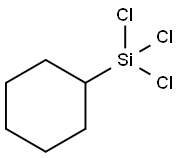시클로헥실트리클로로실란
|
|
시클로헥실트리클로로실란 속성
- 끓는 점
- 90 °C10 mm Hg(lit.)
- 밀도
- 1.232 g/mL at 25 °C(lit.)
- 굴절률
- n
20/D 1.478(lit.)
- 인화점
- 175 °F
- 물리적 상태
- 투명한 액체
- 색상
- 무색 내지 거의 무색
- Specific Gravity
- 1.222
- Hydrolytic Sensitivity
- 8: reacts rapidly with moisture, water, protic solvents
- 감도
- Moisture Sensitive
- BRN
- 2935257
- CAS 데이터베이스
- 98-12-4(CAS DataBase Reference)
안전
- 위험 및 안전 성명
- 위험 및 사전주의 사항 (GHS)
| 위험품 표기 | C | ||
|---|---|---|---|
| 위험 카페고리 넘버 | 14-34 | ||
| 안전지침서 | 26-28-36/37/39-45 | ||
| 유엔번호(UN No.) | UN 1763 8/PG 2 | ||
| WGK 독일 | 3 | ||
| RTECS 번호 | VV2890000 | ||
| F 고인화성물질 | 10-21 | ||
| TSCA | Yes | ||
| HS 번호 | 2931.90.9010 | ||
| 위험 등급 | 8 | ||
| 포장분류 | II | ||
| 유해 물질 데이터 | 98-12-4(Hazardous Substances Data) | ||
| 기존화학 물질 | KE-34065 |
시클로헥실트리클로로실란 C화학적 특성, 용도, 생산
화학적 성질
CLEAR COLOURLESS LIQUID일반 설명
A colorless to pale yellow liquid with a pungent odor. Flash point 185°F. Corrosive to metals and tissue.반응 프로필
Chlorosilanes, such as Cyclohexyltrichlorosilane, are compounds in which silicon is bonded to from one to four chlorine atoms with other bonds to hydrogen and/or alkyl groups. Chlorosilanes react with water, moist air, or steam to produce heat and toxic, corrosive fumes of hydrogen chloride. They may also produce flammable gaseous H2. They can serve as chlorination agents. Chlorosilanes react vigorously with both organic and inorganic acids and with bases to generate toxic or flammable gases.건강위험
TOXIC; inhalation, ingestion or contact (skin, eyes) with vapors, dusts or substance may cause severe injury, burns or death. Contact with molten substance may cause severe burns to skin and eyes. Reaction with water or moist air will release toxic, corrosive or flammable gases. Reaction with water may generate much heat that will increase the concentration of fumes in the air. Fire will produce irritating, corrosive and/or toxic gases. Runoff from fire control or dilution water may be corrosive and/or toxic and cause pollution.화재위험
Combustible material: may burn but does not ignite readily. Substance will react with water (some violently) releasing flammable, toxic or corrosive gases and runoff. When heated, vapors may form explosive mixtures with air: indoors, outdoors and sewers explosion hazards. Most vapors are heavier than air. They will spread along ground and collect in low or confined areas (sewers, basements, tanks). Vapors may travel to source of ignition and flash back. Contact with metals may evolve flammable hydrogen gas. Containers may explode when heated or if contaminated with water.Safety Profile
A highly toxic and corrosive material. When heated to decomposition it emits toxic fumes of Cl-. See also CHLOROSILANES.잠재적 노출
Incompatible with oxidizers (chlorates, nitrates, peroxides, permanganates, perchlorates, chlorine, bromine, fluorine, etc.); contact may cause fires or explo- sions. Keep away from alkaline materials, strong bases, strong acids, oxoacids, epoxides. Chlorosilanes react vigor- ously with bases and both organic and inorganic acids gen- erating toxic and/or flammable gases. Chlorosilanes react with water, moist air, or steam to produce heat and toxic, corrosive fumes of hydrogen chloride. They may also pro- duce flammable gaseous hydrogen. Attacks metals in the presence of moisture.운송 방법
UN1763 Cyclohexyltrichlorosilane, Hazard class: 8; Labels: 8-Corrosive material.시클로헥실트리클로로실란 준비 용품 및 원자재
원자재
준비 용품
시클로헥실트리클로로실란 공급 업체
글로벌( 66)공급 업체
| 공급자 | 전화 | 이메일 | 국가 | 제품 수 | 이점 |
|---|---|---|---|---|---|
| Shanghai Daken Advanced Materials Co.,Ltd | +86-371-66670886 |
info@dakenam.com | China | 15371 | 58 |
| Hangzhou FandaChem Co.,Ltd. | 008657128800458; +8615858145714 |
fandachem@gmail.com | China | 9352 | 55 |
| ATK CHEMICAL COMPANY LIMITED | +undefined-21-51877795 |
ivan@atkchemical.com | China | 32480 | 60 |
| Win-Win Chemical CO., Limited | 0086-577-64498589 |
sales@win-winchemical.com | CHINA | 998 | 58 |
| Hubei xin bonus chemical co. LTD | 86-13657291602 |
linda@hubeijusheng.com | CHINA | 22968 | 58 |
| Hubei Co-Formula Material Tech Co., Ltd. | +86-27-84459282 |
sales@cfmats.com | CHINA | 882 | 58 |
| Shaanxi Dideu Medichem Co. Ltd | +86-029-81138252 +86-18789408387 |
1057@dideu.com | China | 3734 | 58 |
| Shaanxi Dideu Medichem Co. Ltd | +86-029-89586680 +86-18192503167 |
1026@dideu.com | China | 9507 | 58 |
| CD Chemical Group Limited | +8615986615575 |
info@codchem.com | China | 20356 | 58 |
| ShenZhen Trendseen Biological Technology Co.,Ltd. | 13417589054 |
trendseenbio@gmail.com | China | 11681 | 58 |
시클로헥실트리클로로실란 관련 검색:
트리클로로실란 메틸트리클로로실란 부틸트리클로르실란 에틸트리클로로실란 헥실트리클로로실란 시클로헥실트리클로로실란
CYCLOPENTADIENYLTRIMETHYLSILANE
CHLOROCYCLOHEXYLDIMETHYLSILANE
METHYLCYCLOHEXYLDICHLOROSILANE
Cyclohexyldimethoxymethylsilane
3-CYANOPROPYLMETHYLDICHLOROSILANE
Amyltrichlorosilane (mixed isomers)(Pentyltrichlorosilane)
DICHLOROMETHYLSILANE
2-(BICYCLOHEPTYL)TRICHLOROSILANE
ISOPROPYLTRICHLOROSILANE
Trichloropropylsilane
HEXYLDICHLOROSILANE
N-HEXYLSILANE







